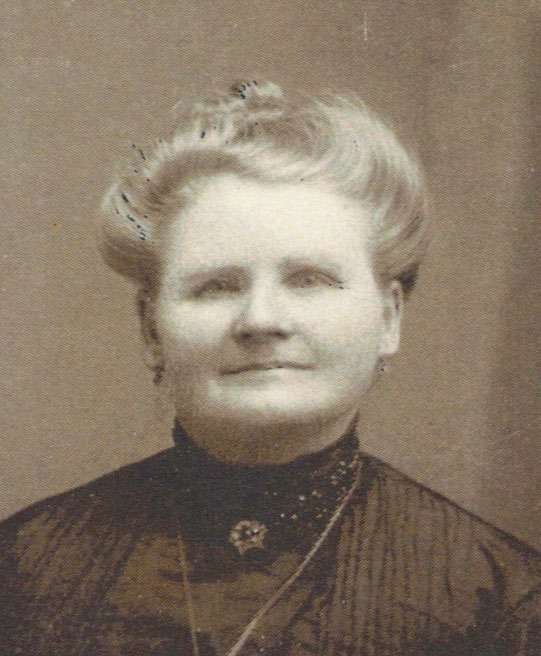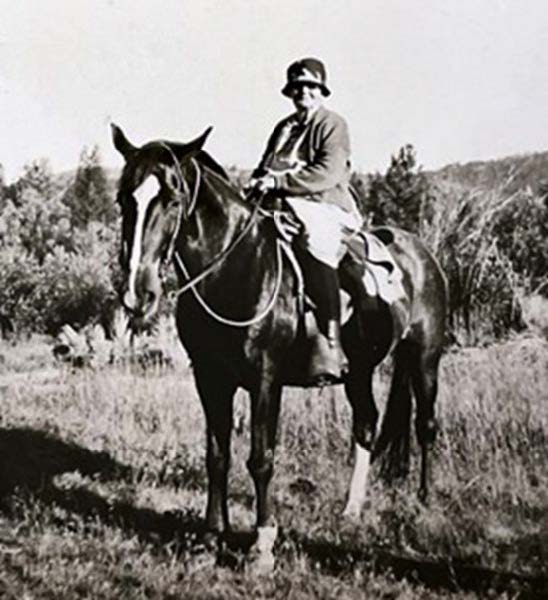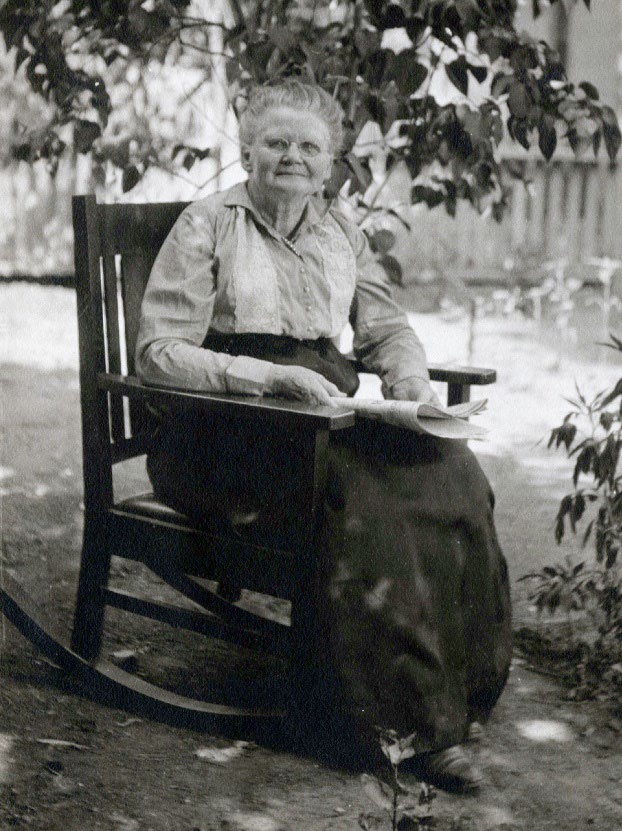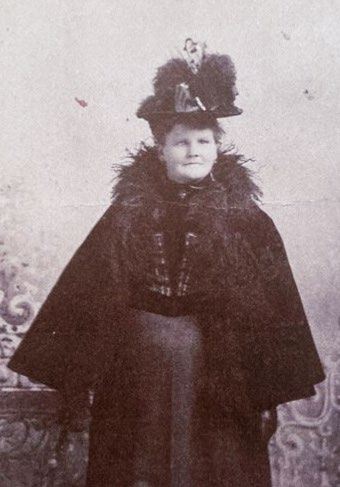The information below has been compiled from a variety of sources. If the reader has access to information that can be documented and that will correct or add to this woman’s biographical information, please contact the Nevada Women’s History Project.

At A Glance:
Born: June 17, 1853
Died: June 6,1938
Maiden Name: Louisa Marie Chubbuck
Ethnicity: Caucasian
Married: William Harris Sweetland, Nov. 27, 1873
Children: Twins Willie and Ella (both died in infancy),
Edgar, Ernest, Sarah (Sade), Grace, George (died young),
Benjamin, Reubel
Primary City/County of residence/work: Carson City, Nevada
Major fields of work: Nevada pioneer, homemaker
Pioneer mother encouraged her inventor son
Louisa Marie Chubbuck was born on June 17, 1853, to George W. and Mary Gardner Chubbuck, in Weymouth, Massachusetts. Her early years were in the eastern U.S., and she spent her adult years in Carson City, Nevada, where she raised her six children, always nurturing their curiosity and encouraging them to learn everything they could. While many children and limited finances meant that she didn’t have a lot of leisure, it is likely that she attended some of the Leisure Hour lectures and may even have shared interests in photography with her sons. According to the October 11, 1887, Daily Appeal article, Mrs. Sweetland won best-colored photograph “in Group 62” at the fall Carson City Fair. She and the family attended the First Presbyterian Church on Division Street, where each of her children was baptized.
My great-grandmother, Louisa Marie Chubbuck, was 10 years old in May 1863 when her family headed from Vineland, New Jersey, to Council Bluffs, Iowa, to join an emigrant train of about 50 wagons heading west. Seventy years later she chronicled her memories for her daughter, Sarah Maude Sweetland Cottrell. The story of young Louisa’s crossing, marked by death, threats from Indians and highwaymen, and several days lost in the desert, was published on June 24 and 25, 1924, in the Carson City Daily Appeal. Click here to see the full article.
One of the first challenges was the death of a child.
We were so far from civilization there was no way of getting a little coffin or getting material to make one so my uncle being along and very handy with tools said if each one would help by what material they would spare, some pieces of wood, nails, and material for lining, he would do the best he could, so he made a little coffin. Each one gave gladly the best that they had…The coffin was made of sixty pieces of wood that different ones gave, and I think thirty pieces of material of different kinds to line the little coffin.
Louisa preferred to ride on a horse or a mule, which her parents allowed her to do, cautioning her to stay within visual distance of the train. Once she disobeyed that order.
I was going a little faster than the wagon train, so I was undecided when I came to a couple of roads running in different directions and right by my side were a couple of men. They did not look very good to me. One said, “Little girl, where are you going, what a fine animal you have.” I started on the road that I thought was the one to take. He said to me, “That is the wrong road.” I began to feel afraid and turned as if I were going to take the other road, instead I just made a quick time and got back to our wagon … No doubt if I had gone the road they told me, I never would have seen my folks again.
They had, too, what Louisa reported as several “thrilling experiences with Indians.”
One of the young men in the party was anxious to try and see how he could shoot with a bow and arrow, so one of the Indians gave him the bow and arrow to see what he could do … It did not take very long for us to find out as the arrow came down and instead of hitting the mark, it struck the Indian in the back. … The old Chief got a lot of his men together and we all thought we would be massacred … My grandmother went in the emigrant wagon and prayed for the good Lord to spare our lives. My sister Lizzie and I were crying … We finally made peace with them by giving them all the tobacco and molasses we had in our train.
They were the last wagon train out of Salt Lake City, having to wait for the mules to be shod. As they were traveling slowly through a deep cut in the mountains, another train asked if they could pass, as they were in a hurry. They turned out to be highwaymen out to trap them in the canyon and take the mules and horses and whatever else they could.
… we children began crying, poor dear mother pleading for our lives, and father doing all he could to protect us, poor old Grandma praying for our safety and for relief to come. It seemed as if her prayers were answered as our uncle and some other men in the train missed us and rode back just in time, as the men had their guns and knives out, either to murder or frighten us, which they most certainly did.
After that terror, they returned to Salt Lake City for the Fourth of July 1863. They stayed 10 days to rest and get their pictures taken and while they were out, “the Mormons stole all of our best clothes.”
Mother had sewed all her nice dresses, father’s broadcloth dress suit, Lizzie’s, and my silk dress we had for best all in three sacks …They also took all our provisions.
Despite the robbery, Louisa remembered Salt Lake City as being “a beautiful place.” They set out for the last leg of their journey across the desert, where, with no other trains in sight, Louisa saw green grass, running water, and nice homes in the distance, but they were all mirages. They had lost the trail.
The weather became so hot we had to travel by night. In some way we got separated from the train and got lost on the desert. We could not find any wagon tracks and traveled around and around for a night and a day and perhaps longer … The water we carried was about gone … to see broken wagons and bones of animals and people that had been lost and died, that was certainly terrible. Again, I think dear old Grandma’s prayers were answered as we saw what looked like a very slight mark of what was an old wagon track, which we followed and were happy when we found it took us to the main road and we were safe once more.

The group camped in Empire, Nevada, then climbed over the Sierra Nevada mountains at the Van Sickle grade and stayed at a place she named “Mud Springs” in El Dorado County, California. The Chubbuck family lived in Placerville for three years before moving to Dayton, Nevada, where Louisa’s father bought woodland in the Como Mountains and made a living for the family by cutting and hauling wood to Virginia City mines.
Six years after they had crossed the plains, the ceremonial Golden Spike linking the Central and Union Pacific railroads was driven in Promontory Point, Utah (May 10, 1869). Louisa’s family “took the first eastbound train.” To sleep they brought boards and “ticks stuffed with hay” cut to fill the gap between seats, but it was an easier crossing than by wagon train six years earlier.
In Vineland, New Jersey, Louisa met and married William Harris Sweetland, an orphaned son of a shoemaker. Perhaps influenced by her parents’ memories of opportunities in the West, Louisa, her parents, her father’s mother, and her new husband left the East Coast. William set up shop as a custom shoemaker on Main Street in Carson City, Nevada.
Louisa Marie Chubbuck Sweetland bore nine children; six survived and one of her three surviving sons was my grandfather, Ernest John Sweetland, who grew up to become an inventor. He was born on “Main” (now Carson) Street in a two-story wooden house with gables, a workshop in front and living quarters for the family of eight in back. Ernest was both curious and ambitious, traits his mother encouraged. She gave him a discarded piano box to convert to a laboratory in the backyard. Louisa’s belief in her son was the encouragement he needed to read and learn. Ernest found mentors at the local chemist shop, the United States Mint across the street and the power station.

Photo from the Sweetland Family Collection
When he was 18, Louisa loaned her ambitious son $5, and Ernest set off for San Francisco with letters of recommendation from his employers and mentors in Carson City. He lived up to his promise to work hard and write home frequently. Later, when Ernest felt he needed more than a fourth-grade education, Louisa sent him an allowance of $25 a week to pay for his assaying classes. The greatest gift Louisa gave to her son was far more valuable. She never pressured him to pay her back, only to work hard and be persistent.
He focused his inventive energy on filtration, a process he had first witnessed at the U.S. Mint as ore was filtered to extract silver and gold. Ernest used his assaying skills in Goldfield, Nevada in 1907, when it was the biggest city in Nevada, producing $10,000 a day in gold and silver. When a mine in Guanajuato, Mexico, bought his filter press idea, he moved there to build it, install it and oversee the operation. In 1909, 10 years after he left Carson City, Ernest landed his first patent for a filter to be used in cyanide goldmining processing.
Over 100 inventions followed, including patents for oil filters for internal combustion engines, an invention which eliminated the need to dump used car oil every few hundred miles. When General Motors installed similar filters in their cars, he sued the gigantic company for patent infringement and although the suit went all the way to the U.S. Supreme Court, he eventually won. This lawsuit (Motor Improvements vs. General Motors Corp) remains a famous one today.

Throughout the many years of struggle, Louisa Sweetland remained her inventor son’s most faithful supporter. In 1929, she used money he gave her to erect a headstone in Lone Mountain Cemetery for her mother and father.
Ernest built a brick building on Carson Street near the Capitol in 1937 to be Louisa Chubbuck Sweetland’s final home. The stones inlaid at the entrance are still there, labeling it the “Sweetland Building.”
By 1930 Louisa was living in Oakland with her daughter Grace’s family. Louisa died in 1938, prior to the completion of the new Carson City building, a tribute to a mother’s enduring confidence in her son.
She is buried in Mountain View Cemetery, Oakland, California.
Written and researched by Jane Sweetland, the great-granddaughter of Louisa Chubbuck Sweetland.
Posted August 2023
Sources of Information
- Ancestry.com. Year: 1880; Census Place: Carson City, Ormsby, Nevada. Page: 53A; Enumeration District: 38. [Louisa C Sweetland]
- Ancestry.com. Year: 1900; Census Place: Carson City, Ormsby, Nevada; Page: 11A; Enumeration District: 36. [Louisa M Sweetland]
- Ancestry.com. Year: 1910; Census Place: Carson City, Ormsby, Nevada; Page: 7B; Enumeration District: 61. [Louisa M Sweetland]
- Ancestry.com. Year: 1920; Census Place: Carson City, Ormsby, Nevada; Page: 3B; Enumeration District: 34. [Louisa Sweetland]
- Ancestry.com. Year: 1930; Census Place: Oakland, Alameda, California; Page: 21B; Enumeration District: 1-145. [Louisa M Sweetland]
- Ancestry.com. California, U.S., Death Index, 1905-1939. [Louisa M Sweetland]
- Ancestry.com. Massachusetts, U.S., Birth Records, 1840-1915. Town of Weymouth for the year, 1853, pg. 261. [Louisa Maria Chubbuck]
- Ancestry.com. New Jersey, U.S., Marriage Records, 1670-1965. Cumberland, 1862-1877, N. Vineland. [Louisa M Chubbuck]
- “Early Carson Resident Dies.” Reno Evening Gazette (Reno, Nevada), 7 June 1938, p. 16.
Exhibits and Premiums. The Daily Appeal (Carson City, Nevada), 11 Oct 1887, p2. - Find a Grave, database and images: https://www.findagrave.com/memorial/126912106/louisa-marie-sweetland: accessed 21 March 2023.
- Kirby, Dale Z., with Gene Sweetland. Ernest John Sweetland and His Fifty Years of Inventing. 1993.
Sweetland, Louisa Chubbuck, “Across the Plains.” Carson City Daily Appeal (Carson City, Nevada), 24, 25 June 1924, p. 4.

